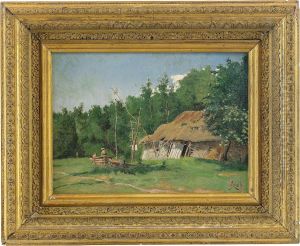Alexander Alexandrovich Kiseliev Paintings
Alexander Alexandrovich Kiseliov, sometimes spelled as Kiselev, was a Russian landscape painter who belonged to the realist tradition and was influenced by the aesthetics of the Wanderers (Peredvizhniki), a group of Russian realist artists who formed an artists' cooperative in protest of academic restrictions. Born on October 1, 1838, in the town of Bezhetsk in the Tver Governorate of the Russian Empire, Kiseliov showed an interest in art from an early age.
Kiseliov pursued his artistic education at the Imperial Academy of Arts in Saint Petersburg, where he studied under the guidance of prominent instructors such as the landscape painter Alexey Bogolyubov. His talent was recognized with awards, including a small gold medal for his work. After graduating with honors, Kiseliov was granted a scholarship to travel abroad and further his studies.
During his travels, he visited various European countries, including Germany, France, and Italy, where he was exposed to a range of artistic styles and techniques. These experiences enriched his approach to landscape painting. Upon returning to Russia, Kiseliov became an active participant in the art scene and joined the Wanderers' movement. His work often depicted the Russian countryside, capturing its beauty through different seasons and times of day. Kiseliov's landscapes are noted for their atmospheric effects and sensitive portrayal of light, which he utilized to evoke mood and emotion.
Kiseliov served as an academician from 1873 and later as a professor at the Imperial Academy of Arts, where he influenced a new generation of Russian artists. Throughout his career, Kiseliov exhibited his works at various venues, including the exhibitions organized by the Wanderers. His paintings were well received, and he garnered respect and recognition from both critics and the public.
Alexander Alexandrovich Kiseliov continued to paint until his later years, leaving behind a rich legacy of Russian landscape art. He died on December 2 (O.S. November 19), 1911, in Saint Petersburg. His works can be found in several Russian museums, including the State Russian Museum in Saint Petersburg and the Tretyakov Gallery in Moscow, as well as in private collections.
